Customer Feedback Analysis 2025: Guide, Tools & Tricks
Tabela de conteúdo
Customer feedback analysis is like Tinder. You’re trying to find the perfect match between what your customers want and what your brand offers. Sometimes the chemistry is instant, other times… it’s an awkward left swipe. But just like dating, success comes down to one thing: listening and learning. Customer feedback analysis helps you understand what your customers love, what turns them off, and how to build a stronger, lasting connection.
- Análise de feedback do cliente is a continuous process of gathering, processing, and interpreting customer opinions to uncover insights that drive better experiences, products, and business decisions.
- Ele combina qualitative and quantitative data from multiple channels, including surveys, social media, reviews, and support interactions, to provide a 360° view of customer sentiment.
- Such an analysis allows you to understand what customers love, what frustrates them, and why they do what they do.
How to analyze customer feedback? 6-step guide
Step 1: Collect and organize all the data
The first step is to collect all feedback from various channels into a single central location. Ideally, you should use reliable, dedicated tools to automatizar o processo e avoid losing valuable insights.
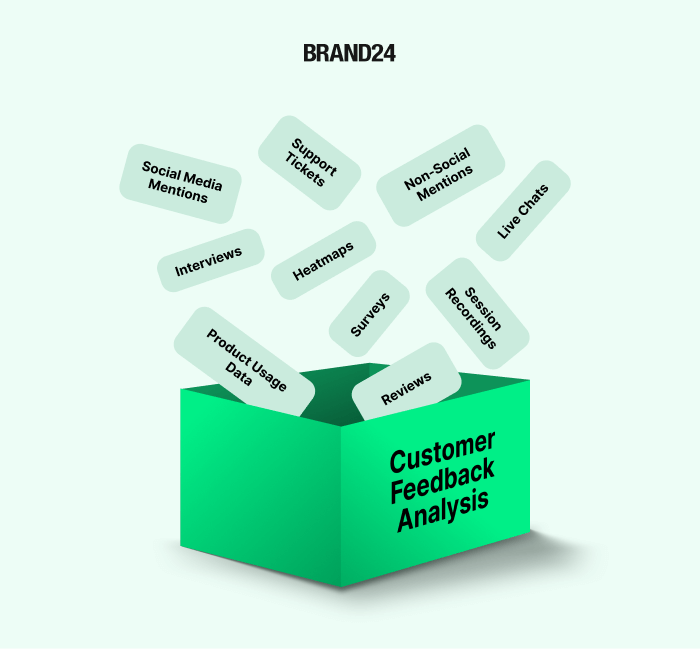
Types of customer feedback analysis tools you should consider:
- Ferramentas de escuta social to monitor mentions across social media, blogs, forums, news sites, and review platforms (i.e., Brand24, Sprout Social)
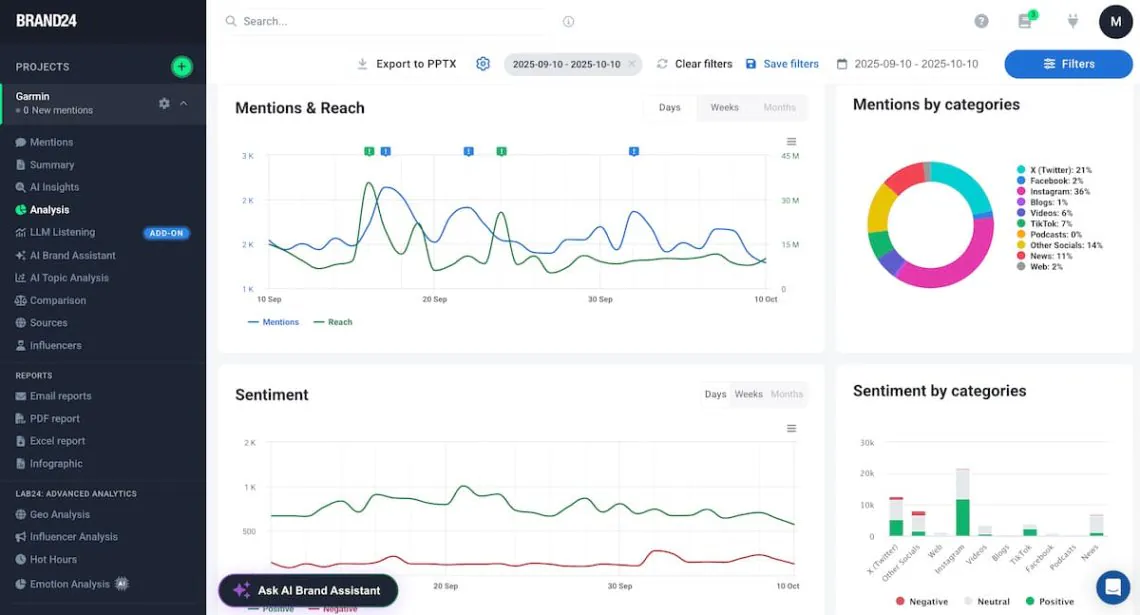
- Survey and feedback platforms to gather direct responses from customers (i.e., Typeform, SurveyMonkey)
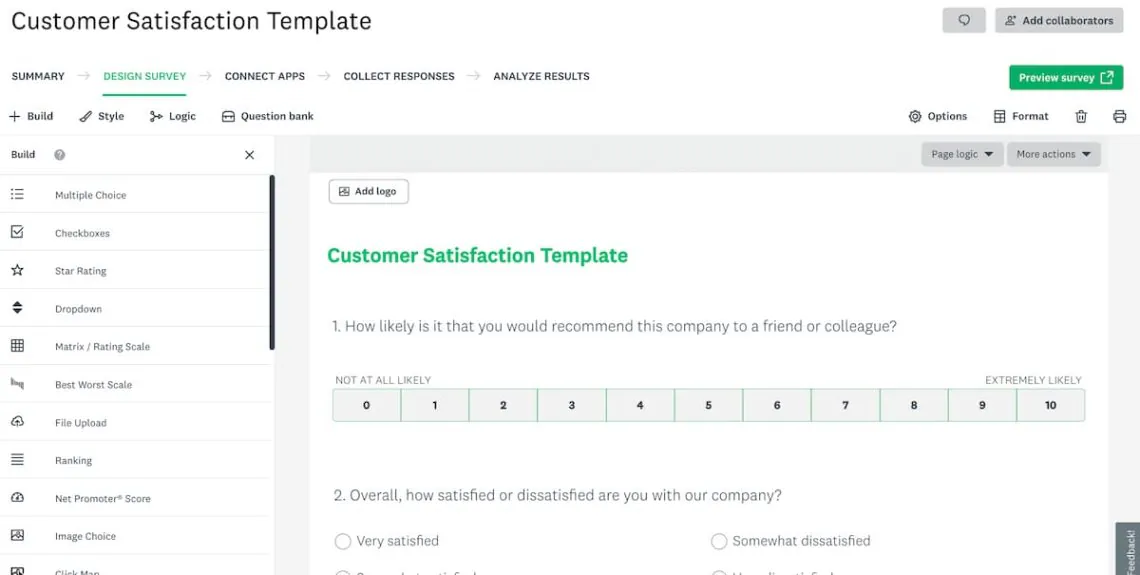
- CRM or helpdesk systems to collect customer feedback from emails, chats, and support tickets (i.e., HubSpot, Intercom)
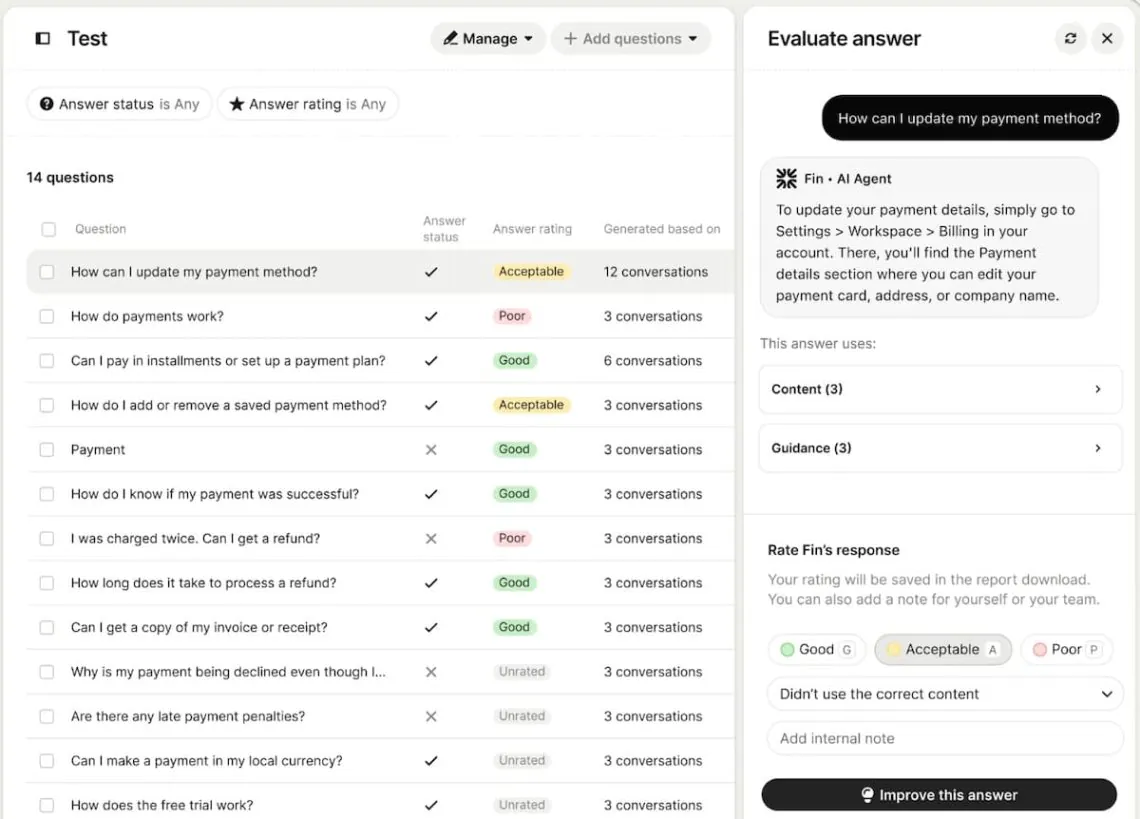
Bringing all this data together provides a comprehensive and unified view of customer sentiment.
To get the most out of your customer feedback analysis, organize all insights in a central repositorycomo, por exemplo:
- Spreadsheet (e.g., Google Sheets, Excel)
- Painel de controle (e.g., Power BI, Tableau)
- Feedback management tool (e.g., Notion, Productboard)
Such organizing feedback in one place makes it easier to filter, tag, and compare insights across different sources.
It also enables you to conduct a more in-depth analysis of your feedback.
Track and analyze customer feedback with Brand24!
Step 2: Focus on feedback that matters
Not all feedback carries the same weight, and analyzing every single comment can be overwhelming.
That’s why the key is to prioritize customer feedback data that has the biggest impact on your brand, product, service, or customer experience.
Start by identifying which feedback is most relevant to your goals. For example:
- To improve customer satisfaction, focus on the most impactful negative comments or recurring complaints.
- To find the opportunities to develop your product, pay attention to feature requests and usability issues (i.e., rage clicks)
- To improve your brand reputation, analyze public mentions, reviews, and social media sentiment.
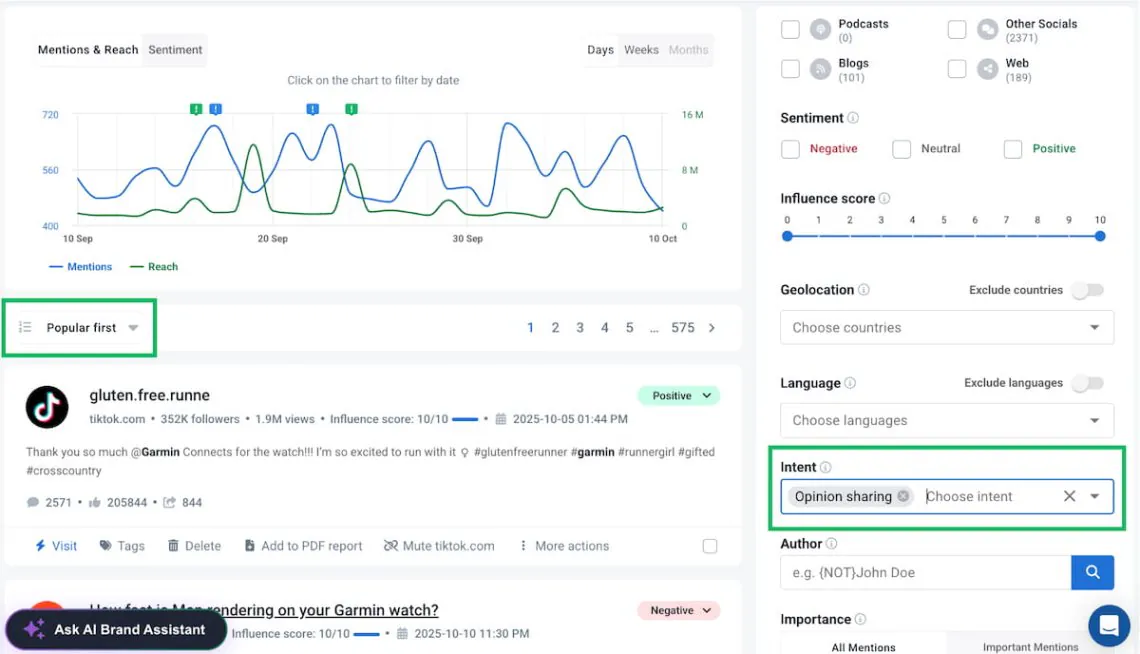
Step 3: Check the overall sentiment
Once you’ve collected and prioritized your feedback, it’s time to understand how customers actually feel sobre sua marca, produto ou serviço.
It sets a kind of starting point that will allow you to evaluate if your future actions indeed improve your customers’ experience and overall brand reputation.
E é aqui que análise de sentimentos entra em cena.
Análise de sentimento uses natural language processing and machine learning to discover the emotional tone of feedback.
In other words, it helps you automatically determine whether feedback is positivo, negativo ou neutro, giving you a quick overview of the overall customer mood.
You can measure sentiment manually by reviewing and tagging each comment. However, this method quickly becomes ineffective when you operate on a large scale.
That’s why a better idea is to rely on AI-powered sentiment analysis tools, which can process thousands of mentions and categorize them automatically.

Solutions like Brand24, Talkwalkerou MonkeyLearn analyze the tone of online conversations, product reviews, and survey responses to show you real-time sentiment trends.
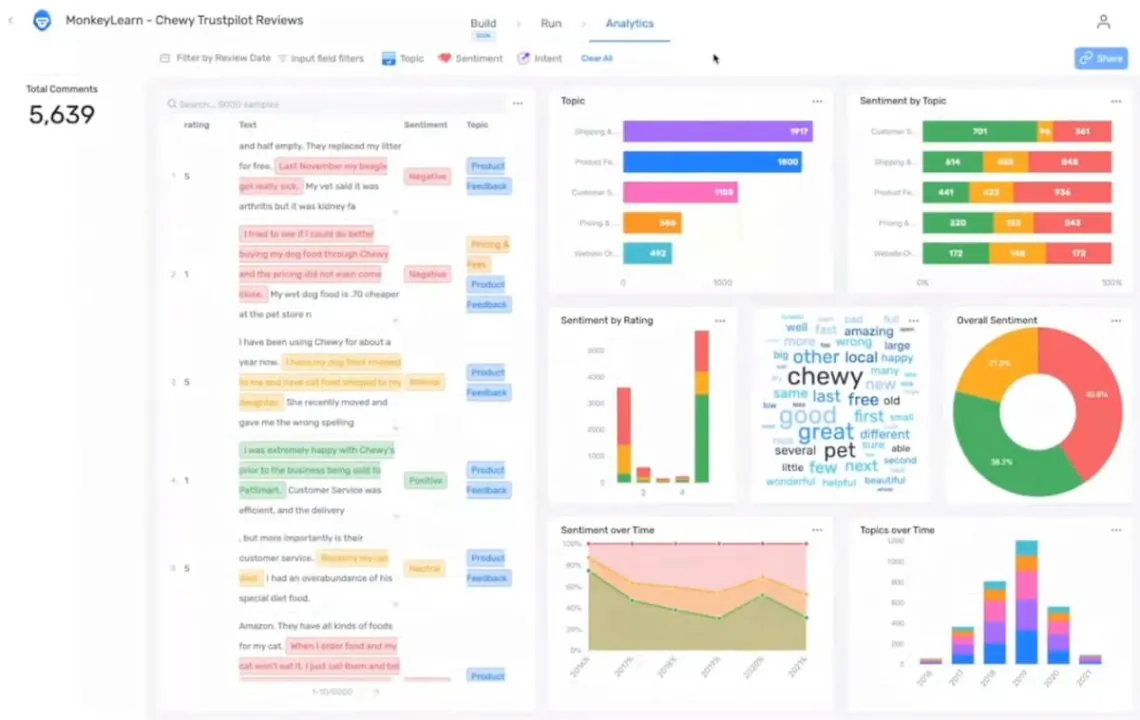
By analyzing sentiment over time, you’ll be able to:
- Track changes in brand perception after campaigns or product updates
- Identify topics that spark positive or negative reactions
- Detect potential crises or customer frustration before they escalate
Understanding sentiment helps you see not just what customers are saying, but how they feel – giving context and emotional depth to your data.
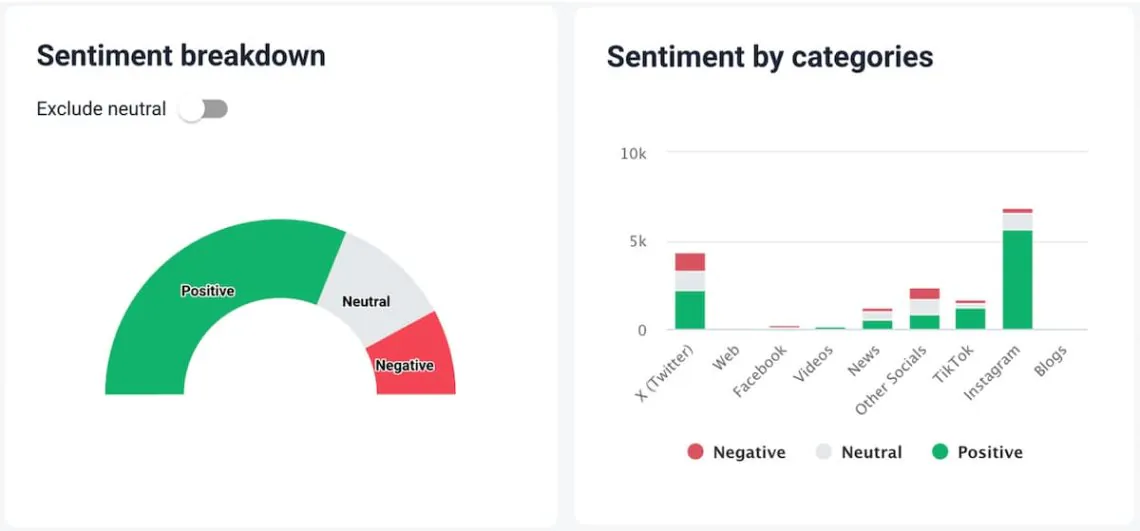
Check your overall sentiment now!
Step 4: Dig deeper into topics
Once you know the general sentiment around your brand, product, or service, it’s time to dig deeper and understand what drives those emotions.
Identify key topics and recurring themes in your feedback. Group similar comments together, such as mentions about customer support, product quality, pricing, or usability.
This allows you to uncover what customers are happy about the most and where they experience frustration.
Some tools, like Brand24, can automatically cluster mentions and visualize which discussion topics have the highest share of voice and sentiment share.
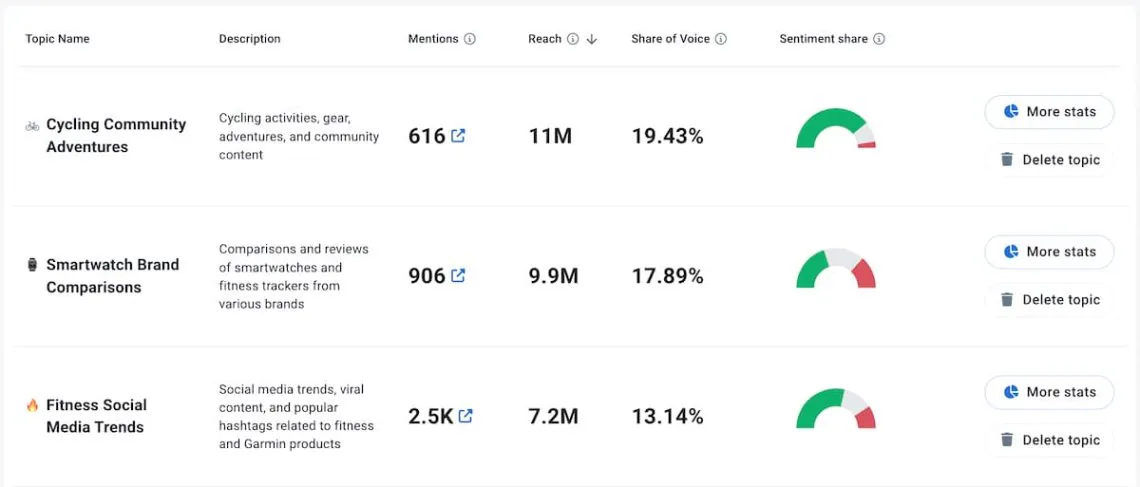
Digging deeper into topics allows you to discover:
- Patterns in customer pain points, such as repetitive complaints or confusing features
- Positive drivers, so what makes people talk about you in a positive way
- Emerging trends, which might reveal future opportunities or risks
By digging into topics, you move beyond surface-level numbers and start uncovering the story behind your customer feedback. These insights will help you understand root causes.
And prepare clear priorities for improvement.
Step 5: Explore trends and patterns
A deeper exploration of trends and patterns in your customer feedback analysis helps you understand how opinions evolve over time and which areas consistently impact customer satisfaction.
Start by looking for:
- Sentiment trends – is the overall tone improving or declining over time?
- Recurring issues – which problems keep appearing across multiple channels?
- Positive trends – what features or experiences drive consistent praise?
- Emerging topics – are there new themes gaining attention among your audience?
In practice, you can do it using AI-powered chatbots, agents, and assistants that help you automatically detect trends and summarize recurring themes.
There are two main ways to approach this:
- Build your own AI workflow
You can copy and paste customer feedback data into an AI tool (like ChatGPT or Notion AI) or connect it to your internal database to create a custom analysis agent.
This method gives you full control and flexibility over what you analyze and how you visualize insights.
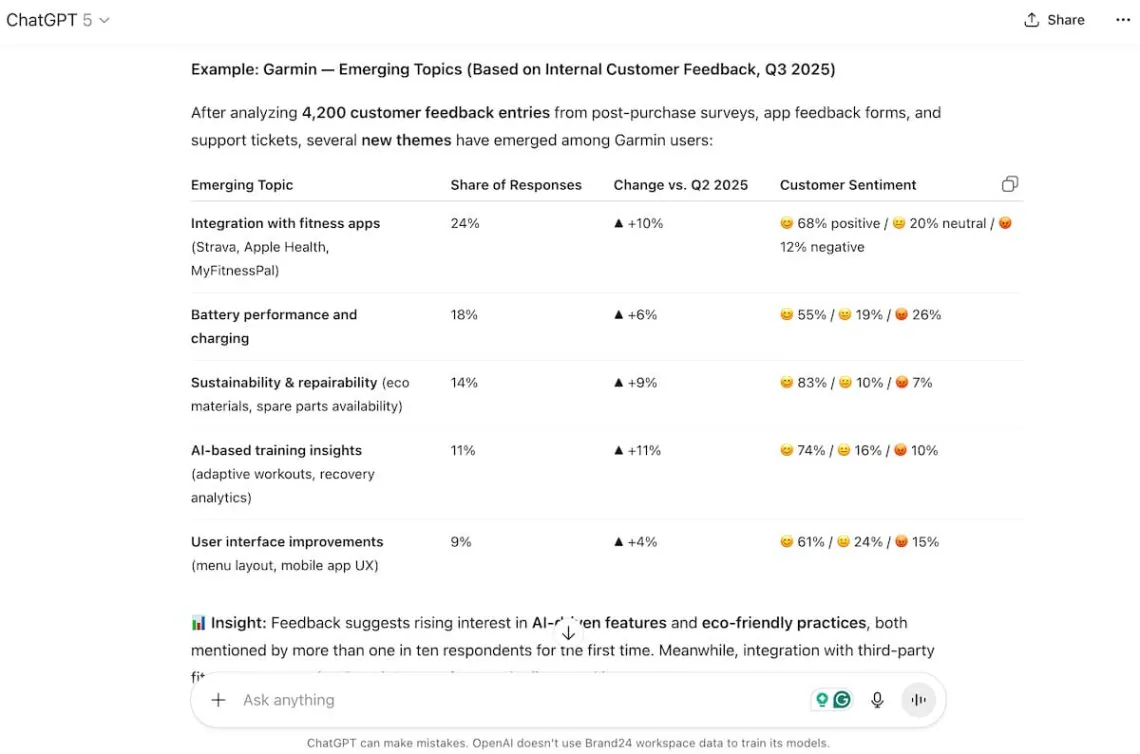
- Use built-in AI features
Many modern tools already include AI-powered chatbots that can recognize sentiment trends, identify popular discussion topics, and summarize customer insights without manual setup.
One example is Brand24’s AI Brand Assistant.
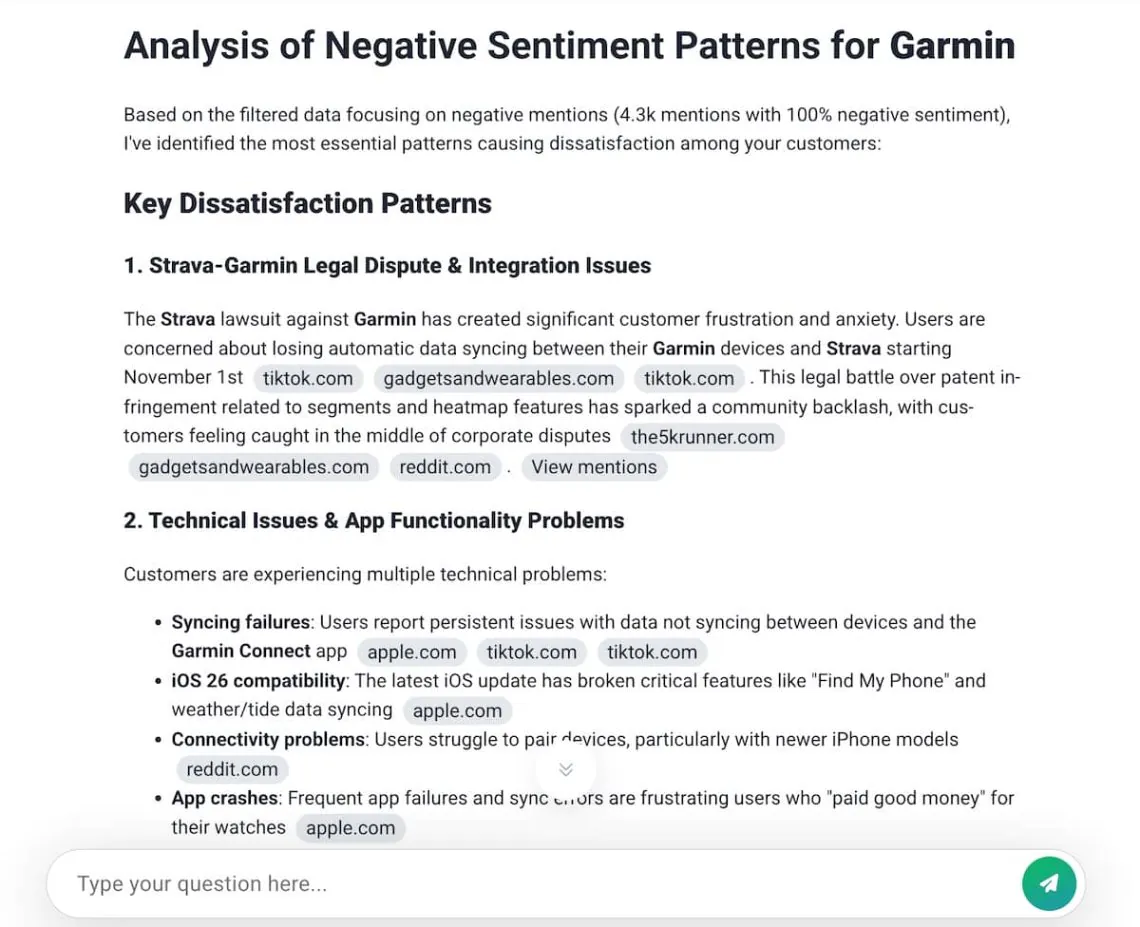
Explore your trends and patterns effortlessly!
Step 6: List action points
The final and most important step in customer feedback analysis is turning insights into action. All in all, feedback analysis process is only valuable if it leads to meaningful change.
Start by summarizing your key findings from the previous steps, including sentiment trends, recurring issues, and positive themes that emerge consistently.
Then, translate them into specific action points for your teams.
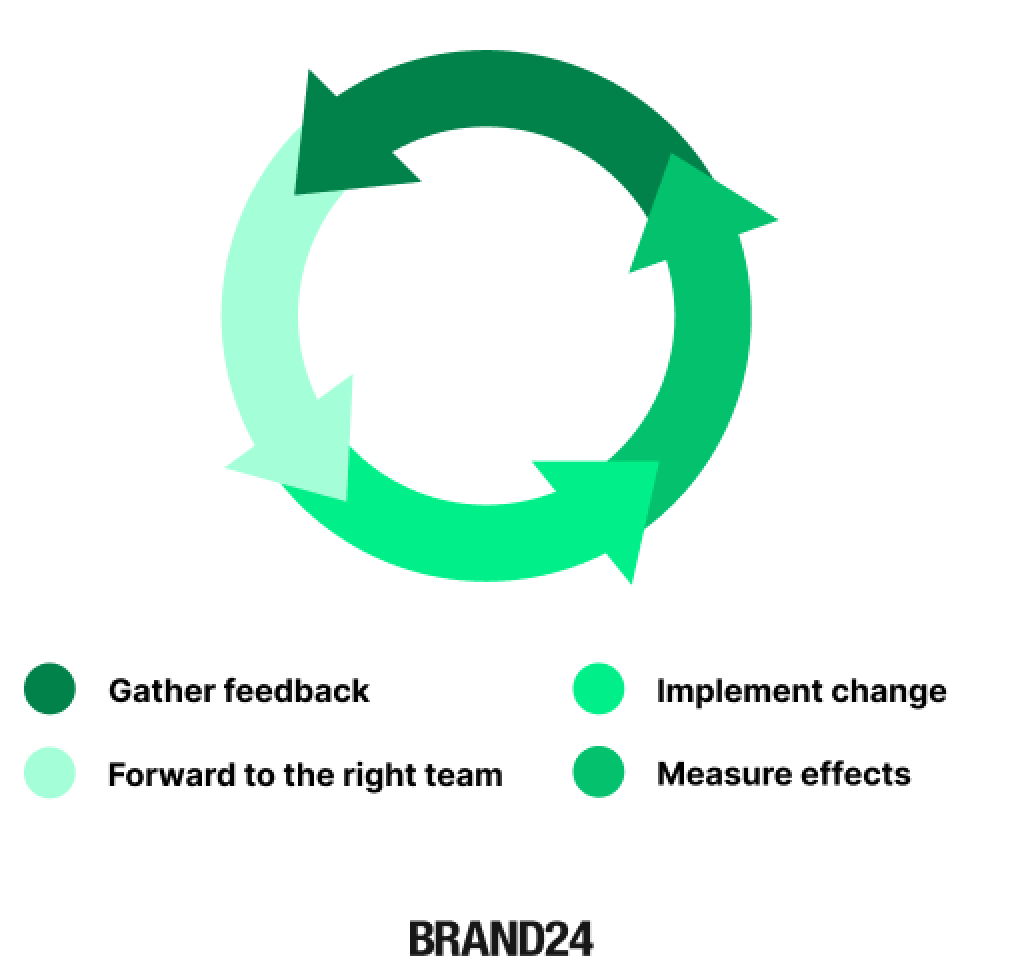
Por exemplo:
- If customers complain about response times → improve your support workflow ou introduce automation.
- If users highlight product bugs or problematic features → forward insights to your product or UX team.
- If customers praise a new feature or campaign → implement it in your marketing strategy.
Each action point should be measurable (so you can track progress) and assigned to the right team or owner. This ensures accountability and creates a feedback loop, turning customer insights into continuous improvement.
Finally, make sure to track the impact of your actions.
Monitor how sentiment, satisfaction scores, and engagement metrics change over time to evaluate whether your initiatives truly enhanced the customer experience.
Remember: the goal of customer feedback analysis isn’t just to listen — it’s to learn, act, and improve continuously.
PERGUNTAS FREQUENTES
What is customer feedback analytics?
Customer feedback analysis is the process of collecting and interpreting customer comments & reviews that aims to provide actionable insights about their experiences with a brand, product, or service.
It involves gathering and analyzing feedback from:
- Quantitative data – measurable métricas de sucesso do cliente, such as satisfaction scores (NPS, CSAT), ratings, usage trends, or behavioral data. They reveal how much or how often something occurs.
- Qualitative data – insights expressed in words, such as survey responses, interviews, support tickets, live chats, social media mentions, and online reviews. This data helps you understand the why behind customer opinions.
Why should you care about customer feedback analytics?
Customer feedback analysis is hugely important because:
- It helps identify weaknesses in your product or service, so you can address and improve them
- It increases your understanding of customer needs, so you can improve their satisfaction and loyalty
- It gives you ideas about what your top strengths are, so you can use them in your marketing communication
- It provides data for business decisions, so you can prioritize resources and develop new features.
Try Brand24 – the best customer feedback analysis tool!
How to find data for customer feedback analytics? Methods
The quality of your customer feedback analytics depends on the quality and variety of the data you collect.
To get a 360° view of the customer experience, combine multiple data sources and methods, both direto e indireta.
Here are the most effective ways to find and collect customer feedback data:
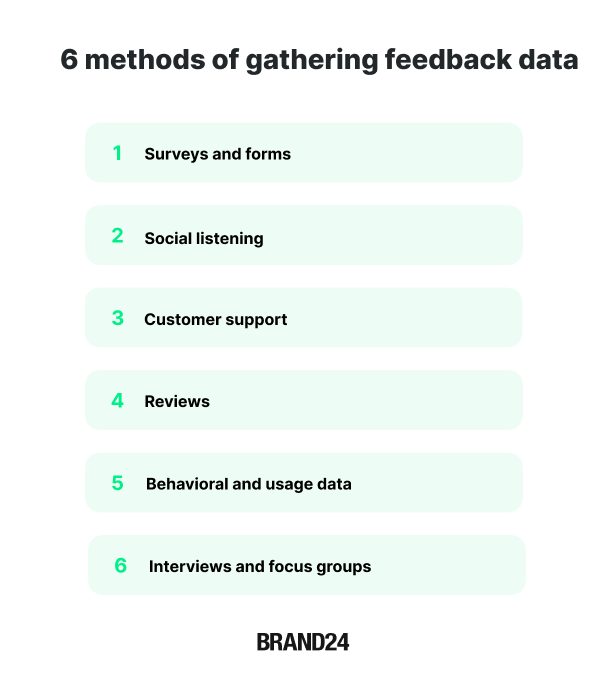
1. Surveys and forms
Use online surveys, in-app questionnaires, or post-purchase forms to collect structured, quantitative data. You can ask about satisfaction (CSAT), likelihood to recommend (NPS), or ease of experience (CES).
Tools: Typeform, SurveyMonkey, Google Forms, Survicate
2. Social listening
Monitor social media platforms, blogs, forums, and review sites to gather and analyze qualitative feedback from natural user conversations. Social listening gives you access to both positive and negative thoughts your customers share publicly.
Tools: Brand24, Sprout Social, Mention
3. Customer support interactions
Analyze helpdesk tickets, live chats, and emails. These are gold mines of problem-oriented feedback, revealing repetitive pain points or areas for improvement.
Tools: Intercom, Zendesk, HubSpot
4. Online reviews
Monitoramento de revisão provides priceless insights about customer satisfaction. Tracking reviews from sites like Google, G2, Trustpilot, or Yelp helps identify sentiment trends and changes in reputação da marca ao longo do tempo.
5. Behavioral and usage data
Mix feedback with quantitative behavioral data, such as session recordings, heatmaps, churn metrics, or product usage analytics. This reveals what customers actually do, not just what they say.
Tools: Hotjar, Mixpanel, Google Analytics
6. Interviews and focus groups
Conduct one-on-one interviews or small group discussions to explore the why behind customer opinions. This qualitative method provides depth, context, and emotional insight that surveys often miss.
Leia mais: Como coletar feedback dos clientes?
What are the best customer feedback analytics tools to use in 2025?
There are many customer feedback analysis tools that we can split into one of three types:
- Ferramentas de escuta social – to collect direct & indirect feedback from online discussions about brands, products, and services
- Survey & ferramentas de feedback do cliente – to collect structured feedback data directly from users
- CRM & helpdesk tools – to collect feedback via support interactions, chats, tickets, and surveys
To make things easier, I’ve prepared a quick comparison table featuring six of the best tools to use in 2025 (two from each category).
| Categoria | Ferramenta | Top 3 strengths | Melhor para | Veredicto geral |
| Escuta social | Brand24 | • Real-time mention tracking • AI-powered sentiment analysis • AI-supported customer feedback analytics features | Marketing teams, PR specialists, customer experience managers | A powerful, user-friendly tool for tracking brand reputation and understanding customer sentiment at scale |
| Escuta social | Sprout Social | • Advanced social analytics • Multi-platform management • Collaboration features | Social media managers, marketing teams, agencies | Great for teams that want to combine engagement management with detailed reporting |
| Survey & Feedback | Survey Monkey | • Custom survey templates • Strong analytics • Easy integrations | Product teams, researchers, HR professionals | A good choice for collecting and analyzing structured customer opinions |
| Survey & Feedback | Typeform | • Engaging form design • High response rates • Excellent UX | Startups, marketing teams, UX designers | Great for turning traditional surveys into engaging, user-friendly experiences |
| CRM & Helpdesk | HubSpot Service Hub | • Unified customer database • Automation & workflows • NPS and feedback tools | Customer service teams, SaaS companies | A complete solution for managing customer relationships and acting on feedback |
| CRM & Helpdesk | Interfone | • Live chat & bots • Personalized messaging • Easy integration with CRM tools | SaaS companies, digital support teams | Perfect for businesses that prioritize real-time, conversational customer support |
Track and analyze customer feedback with Brand24!
Conclusão
Customer feedback analysis helps brands understand their audience and make smarter, data-driven decisions.
It combines qualitative and quantitative data from multiple channels to build a complete picture of customer sentiment.
The whole process involves gathering & organizing feedback, analyzing emotions, spotting trends, and turning insights into concrete actions.
Together with the right escuta social, survey & feedback, as well as CRM & helpdesk tools, they create an ecosystem that turns raw opinions into clear business insights.
The key is to keep the process continuous – always listening, improving, and measuring results.
When done well, feedback analysis strengthens trust, improves products, and boosts long-term loyalty.
Considerações finais:
- Every customer opinion is crucial to better decision-making.
- Automate what you can, but never forget about empathy
- Listening is just the beginning. Learning and changing are what truly matter.
Inicie um teste gratuito de 14 dias do Brand24 and boost your customer feedback analysis!
Artigos relacionados


![Como rastrear notícias Mentions? [2025]](https://brand24.com/blog/app/uploads/2024/05/news_mentions_brand_image_blog_cover_615x345_czekadelko2_24-600x335.png)
![Como rastrear X (Twitter) Mentions? [2025]](https://brand24.com/blog/app/uploads/2024/02/Xtwitter_mentions@2x-600x335.webp)
![Como rastrear Mentions da Twitch? [2025]](https://brand24.com/blog/app/uploads/2024/07/twitch_mentions_brand_image_blog_cover_615x345_czekadelko2_41-600x335.png)
![Como rastrear Mentions do Facebook? [2025]](https://brand24.com/blog/app/uploads/2024/02/facebook_mentions_brand_image_blog_cover_615x345_czekadelko2_4-600x335.png)